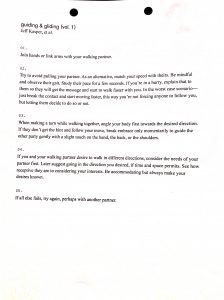While the title of this post is ambiguous at best and horribly abstruse at worst (by the way, linguist’s nerdy moment: the word “abstruse,” which means “difficult to understand, obscure,” is in itself abstruse), I think it’s the best way to describe a piece of installation art by Jeff Kasper in an exhibit I saw at the Graduate Center of CUNY, where I study. The two images, shown here are scans of pages free to the public that accompanied videos playing on screens in the wall:


Both pages display what appear to be instructions, steps by which to engage with another person in a physically proximate walk with a partner (vol. 1), or to meet up with friends and go out as a repeated habit (vol. 2). The strange vagueness with which physicality is referred to (for example, vol. 2 states, “Touch each other. Support each other physically.”) is complemented by the uncertain, almost alien way in which the interpersonal content is referred to (in vol. 1, there is simply mention of one’s “walking partner,” leaving the intended audience to wonder whether these instructions are meant for use with close friends, lovers current or to-be, family members, someone else). What is particularly interesting – and unnerving, to me – is the step-by-step breakdown of such mundane experiences, which are as universal to people around the world as one can imagine and as expressive of how we unconsciously experience human physicality in public spaces.
But what if this piece is meant to signal just that, a shift in the universality of human physical interaction? We are already seeing it, in the ways in which screens – on which I am typing this, and on which someone might be reading it – draw our eyes away from each other, making even intimate spaces like elevators, subway cars, and seats at the dinner table experiences of great interpersonal distance. Perhaps the point is that human beings may lose a sense of what it means to interact with each other as physical beings that share common language, so to speak, about embodied sociality.
And then the twist came: What if I myself am not the intended audience, or rather, what if there is an audience for these instructions for whom I am a second audience? It seems that any typical human being would have had such experiences naturally, over the course of his/her life as a part of being socially physical. But what if these instructions are written…for those who have not had such experiences?

For better or worse, my sci-fi background (mostly TNG) provides me with broad, fantastical references to alternate possibilities and ways of perceiving our reality, much the way art can and should. It dawned on me that instead, the artist might instead be “speaking” to a non-human entity who might be learning to be human, perhaps through an instruction guide. The proceduralization, ugly and awkward as a guide for how to do laundry for a new college student, adds a particularly interesting dimension when considering the question of physicality. We rarely question our physical being, instead following them through our worlds as the mediators of engagement for socializing, labor, consumption, pleasure, transportation, rest, exercise, and so on as simply the natural aspect of our corporeal selves. But what if, like Scarlett Johansson’s well-played character in Under the Skin (which I would strongly recommend, by the way), the being reading this procedure was doing so for the first time? What might physical intimacy, careless and simple as it might sound to us, appear to look like as a subject of study?
Amazing how art, sudden, brazen, incisive art, can bring into one’s mind a powerful vision of the self that had not yet occurred. What else, might we wonder, could art teach us in a reality that seems completely out of our hands nowadays, a runaway train of lies and white supremacy and violence and androcentrism and horrible vanity in which we are desperate to have a stake? What assumptions might crumble at such a reckless and restless time?

